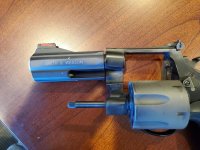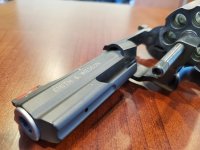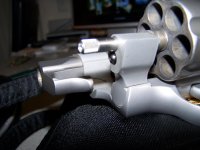Bummer... I suspect S&W will take care of you.
I can see that the frame cracked at the bottom where the barrel threads in. That’s the thin spot and where that type of failure typically occurs. S&W blames it on over torquing at assembly, but I’m not so sure that's the cause. “Scandium” aluminum alloy is very hard and has different expansion and contraction rates compared to steel.
The same thing happened to my PC 625-10 while shooting and I’ve seen well over a dozen similar failures on alloy frame guns (two in person, the rest on the forum). Even new in box guns have been found cracked. I always open the cylinder and inspect that area when purchasing an alloy frame revolver.
I caught the crack on mine before the frame completely failed. I noticed difficulty opening the cylinder, made a quick inspection and was heartbroken. Chances of being injured from this type of failure are extremely slim. The bullet is trying to drive the barrel forward and in a worse case scenario, it does!
I wouldn’t mention that you were shooting reloads when communicating with S&W.









